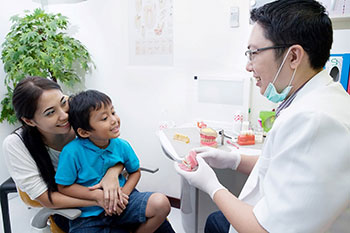 The best thing about a routine childhood dental examination is the chance for the dentist to find treatable problems in your child's mouth. Parents and caregivers don't always know how to spot tooth issues, but dentists have special training to identify problems that need to be fixed.
The best thing about a routine childhood dental examination is the chance for the dentist to find treatable problems in your child's mouth. Parents and caregivers don't always know how to spot tooth issues, but dentists have special training to identify problems that need to be fixed.
Children have fewer problems with their teeth when they see the dentist regularly and follow good oral hygiene habits. However, schedule routine childhood dental exams to catch the following problems early.
Malocclusion
Malocclusion is the state of teeth that are misaligned. Misaligned teeth are a common problem in childhood. In one study, malocclusions were identified in 66 to 70 percent of children aged three years.
Malocclusion in one child's mouth can be a failure of top and bottom front teeth to join when chewing. Another child may grow upper molars that fail to grind directly over lower molars. Children with malocclusions may have trouble eating, pain in their mouths, and problems cleaning their teeth.
Malocclusions occur for a variety of reasons. Some overbites and underbites are a matter of genetics. Some overbites are due to thumb-sucking, pacifier use, and other non-nutritive sucking. Other malocclusions may cause or be worsened by mouth breathing, teeth grinding, and snoring.
Trauma to baby teeth can cause malocclusions as permanent teeth erupt. Always have babies and toddlers checked out by a pediatric dentist after any mouth injury from a hard fall or other hit to the face. Schedule a dental exam if your child's bite seems uneven or they complain about chewing difficulty.
The earlier a dentist identifies malocclusions of the mouth, the sooner a child can have their teeth aligned properly. Studies are showing an increased interest in starting orthodontia and other restorative therapies earlier in children's lives to shorten their time in braces and retainers as teens.
Taurodontism
The name of this condition comes from the Greek words for bull and tooth. A taurodont tooth is a tooth that's rectangular in shape like a well-defined bull. The tooth has less stable roots than a normal tooth. The roots are also shorter than average tooth roots.
Taurodontism is a common tooth anomaly among Eskimo people and indigenous peoples of Central America and Australia. No one is sure why some teeth grow to become taurodont and other teeth don't, but scientists suspect primary tooth cell issues could be to blame.
Taurodontism is sometimes associated with the following developmental diseases:
- Down syndrome
- Klinefelter syndrome
- Lowe syndrome
- Mohr syndrome
- Wolf-Hirschhorn syndrome
Taurodontism most often affects the permanent molars. A dentist must spot the condition on x-rays or scans of your child's mouth since the condition is hard to see. Your child's dentist will tread carefully around a taurodont tooth since teeth with the condition are very hard to extract, prepare for crowns, and make ready for bridges.
Dentists can also have difficulty performing root canals on taurodont teeth due to the shortened roots of the teeth. When a child is diagnosed with taurodontism, the child's dentist prepares a special care plan to accommodate the condition.
Leong's Premolar
Leong's premolar, also called dens evaginatus (DE) and talon cusp, is an enamel-covered, pulp-filled protrusion that extends from a surface of a tooth. The protrusions can be painful and interfere with a child's ability to chew and speak.
Dentists diagnose most DEs on the premolars of children. However, DEs may also occur on incisors, canine teeth, and molars. Both primary and permanent teeth can be affected by the condition.
Dentists spot DEs during routine dental screenings. They treat the protrusions using the best methods for the position of the protrusion and the plan for the affected tooth.
Sometimes, dentists grind DEs down over a gradual time period. Since the DE has some pulp material in the protrusion, the DE is prone to trauma or infection of the pulp. The pulp infection could affect adjacent teeth, so dentists slowly grind the protuberance away to avoid pulp trauma.
After the dentist performs each grinding procedure, they seal the tooth with various treatments including fluoride and desensitizing agents. When the protrusion is flush with the tooth or removed, the dentist may seal the area with resin to keep out germs and food particles.
If your child has DEs, the pediatric dentist will explain all of the treatment options to you. In some cases, the DE will not cause problems, so no treatment is necessary.
As with all dental issues of childhood, DEs present challenges for your child and their dentist. By scheduling routine childhood dental exams, you give your dentist the opportunity to catch issues including malocclusion, taurodontism, and DEs before the problems cause serious harm to your child's mouth or health.
Whether your child has a mouth full of shiny, white teeth or you're worried about your child's tooth problems, contact Dentistry for Children & Adolescents today to schedule a complete pediatric dental exam in Minnetonka, Edina, or Burnsville, Minnesota. We're dedicated to providing compassionate, skilled dental services for young people of all ages.
